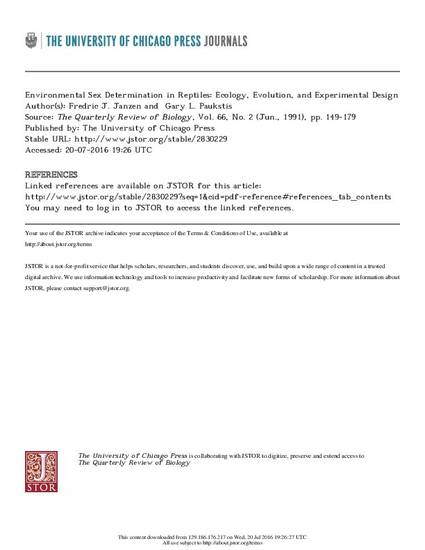
Article
Environmental Sex Determination in Reptiles: Ecology, Evolution, and Experimental Design
The Quarterly Review of Biology
(1991)
Abstract
Sex-determining mechanisms in reptiles can be divided into two convenient classifications: genotypic (GSD) and environmental (ESD). While a number of types of GSD have been identified in a wide variety of reptilian taxa, the expression of ESD in the form of temperature-dependent sex determination (TSD) in three of the five major reptilian lineages has drawn considerable attention to this area of research. Increasing interest in sex-determining mechanisms in reptiles has resulted in many data, but much of this information is scattered throughout the literature and consequently difficult to interpret. It is known, however, that distinct sex chromosomes are absent in the tuatara and crocodilians, rare in amphisbaenians (worm lizards) and turtles, and common in lizards and snakes (but less than 20 %o of all species of living reptiles have been karyotyped). With less than 2 percent of all reptilian species examined, TSD apparently is absent in the tuatara, amphisbaenians and snakes; rare in lizards, frequent in turtles, and ubiquitous in crocodilians. Despite considerable inter- and intraspecific variation in the threshold temperature (temperature producing a 1:1 sex ratio) of gonadal sex determination, this variation cannot confidently be assigned a genetic basis owing to uncontrolled environmentalfactors or to differences in experimental protocol among studies. Laboratory studies have identified the critical period of development during which gonadal sex determination occurs for at least a dozen species. There are striking similarities in this period among the major taxa with TSD. Examination of TSD in the field indicates that sex ratios of hatchlings are affected by location of the nests, because some nests produce both sexes whereas the majority produce only one sex. Still, more information is needed on how TSD operates under natural conditions in order to fully understand its ecological and conservation implications. TSD may be the ancestral sex-determining condition in reptiles, but this result remains tentative. Physiological investigations of TSD have clarified the roles of steroid hormones, various enzymes, and H- Y antigen in sexual differentiation, whereas molecular studies have identified several plausible candidatesfor sex-determining genes in species with TSD. This area of research promises to elucidate the mechanism of TSD in reptiles and will have obvious implicationsfor understanding the basis of sex determination in other vertebrates. Experimental and comparative investigations of the potential adaptive significance of TSD appear equally promising, although much work remains to be performed. The distribution of TSD within and among the major reptilian lineages may be related to the life span of individuals of a species and to the biogeography of these species. Answers to many of the questions and tests concerning TSD in reptiles would be facilitated by controlling the conditions of incubation, by standardizing the experimental design, and by depositing voucher specimens in accessible collections after completion of the study. Goals for future research are discussed.
Disciplines
Publication Date
June, 1991
Publisher Statement
Copyright 1991 by The University of Chicago.
Citation Information
Fredric J. Janzen. "Environmental Sex Determination in Reptiles: Ecology, Evolution, and Experimental Design" The Quarterly Review of Biology Vol. 66 Iss. 2 (1991) p. 149 - 179 Available at: http://works.bepress.com/fredric-janzen/12/
